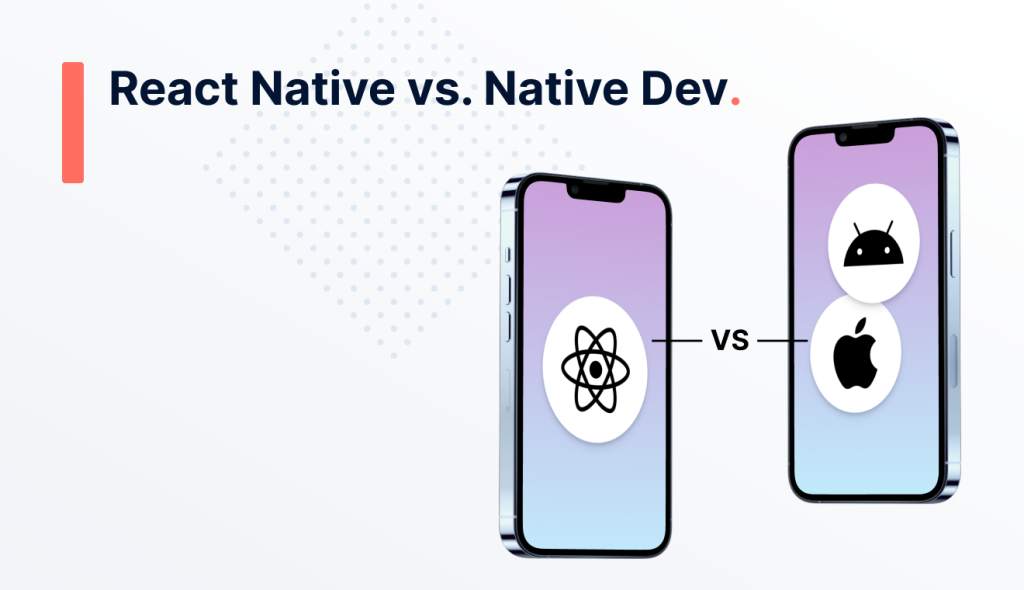The world of mobile apps is primarily divided into two major operating systems: Android and iOS. If you aim to create a popular app with global reach, it is advisable to publish it on both platforms.
When it comes to having an Android and iOS version of your app, you have two options: developing two separate native apps or utilizing a technology such as React Native, which enables you to create versions for both systems simultaneously.
In this post, we will explore both approaches and provide five reasons why opting for React Native in your app development is beneficial.
What Is Native Development
Native development refers to the process of creating software applications specifically for a particular platform. In the realm of mobile development, native development involves building apps designed for a specific device, such as an iPhone (iOS) or an Android smartphone.
Each mobile operating system provider, such as Apple, Google, or any other mobile OS operator, offers a set of tools to facilitate and optimize the app development process for their respective operating systems. These development platforms provide a comprehensive range of functionalities to assist developers in creating apps that take full advantage of the device’s features and capabilities.
Apple and Google provide robust development platforms that are rich in functionalities, enabling developers to create apps that leverage the latest OS versions and utilize the specific features available on the devices.
What does it mean in practice?
If you intend to develop for iPhones, you will most likely utilize the Xcode program, which generates app code using Swift, a programming language developed by Apple. On the other hand, to create the same app for Android, you would likely use Android Studio and write the code in either Java or Kotlin, the newer programming language introduced by Google.
The significant advantage of native development is the ability to have complete control over the specific features offered by each platform as soon as they are introduced. Sometimes, these features are accessible to developers even before they are made available to users. For instance, if a new iPhone includes a sensor to measure room temperature, Apple will update the development tools to allow developers to incorporate this sensor into their apps. This could enable functionalities such as displaying the current room temperature or implementing other applications that developers can envision using this capability on the phone.
This example also demonstrates that features and capabilities can vary significantly between different devices, and the technologies employed in app development are entirely distinct. Therefore, if you wish to create a native app that is accessible to a wide audience, you must develop two separate apps: one for Android phones and another for iPhones.
That necessity of creating basically two applications makes the development much more complex and expensive. This is why React Native has been created.
What is React Native?
React Native is a technology created by Facebook that aims to address the problem of developing separate apps for different platforms. Its objective is to enable developers to write code once and make it available on both Android and iOS.
Why is it called “React Native”?
The name “React Native” provides valuable insights into the objective and functionality of this technology.
The first part of the name, “React”, originates from another technology developed by Facebook called ReactJS. If you are familiar with web development, you may already be acquainted with ReactJS. Facebook introduced ReactJS to simplify web development. Given its popularity and widespread usage, Facebook decided to adopt similar structure for React Native. This allows developers who are already familiar with ReactJS to apply their existing knowledge to mobile app development as well.
The second part of the name, “Native”, refers to native development, as explained in the previous section. This term has been employed because the primary aim of React Native is to create applications that possess the look and feel of native apps. This means that users browsing the app on Android or iOS should not be able to discern whether the app was developed natively or with React Native.
How does it work?
To grasp the fundamental workings of React Native, let’s briefly revisit a key aspect of native development.
As previously discussed, mobile ecosystem providers offer technologies that developers can utilize to create platform-specific apps. These technologies include foundational components that serve various purposes within an app. For instance, there are components for displaying text, images, buttons and other capabilities required by an app.
React Native essentially provides the same set of components required for app development. Behind the scenes, React Native maps each component to its corresponding native component for Android and iOS. This means that you can develop a mobile application using the JavaScript programming language and the structure of the ReactJS library, which closely resembles the process of creating a web application with ReactJS. React Native will automatically generate two native apps for you and translate the code Android and iOS, allowing you to distribute your app on both platforms.
Example: The App Navigation
Imagine you want to develop a native app for Android. Google offers developers the Bottom Navigation component, which is a user interface element that appears on the screen like this:

Similarly, Apple offers its own component to create a similar bottom navigation for iOS, which may have slightly different capabilities and default animations compared to Android.
React Native also provides a bottom navigation component. When you utilize this component, React Native automatically translates it into the corresponding standard components for Android and iOS. As a result, users on both Android and iOS will experience a bottom navigation that aligns with their platform’s conventions. It will look an behave as if it has been developed natively for each platform.
Pros And Cons Of Native Development
Now that we have gained a better understanding of native development and React Native, along with the problems it aims to solve, let’s discuss the advantages and disadvantages of these approaches more explicitly.
Pros Of Native Development
Earlier Access To New Opportunities
As discussed previously, the tools and technologies employed in native development are maintained by companies that have control over the hardware and/or software platforms on which applications are executed. These companies place great importance on developers actively creating new apps for their respective platforms. Consequently, they consistently strive to ensure that developers have access to the most up-to-date tooling, enabling them to leverage the full capabilities of new devices.
Better Full Access To The Underlying Hardware Capabilities
In native development, it is easier to have direct access to the device's underlying hardware, allowing for seamless integration with sensors and capabilities like Bluetooth. React Native also provides access to such functionalities, but it may require more development work and time to incorporate them. Native development offers immediate and direct access, while React Native prioritizes code sharing and cross-platform development.
Probably Better Performance
Native applications, utilizing technologies specifically designed for a particular device, generally offer better performance. However, in most cases, the performance difference is negligible and goes unnoticed by end users. It is only in scenarios where heavy processing power is required, such as applications with extensive visual animations, 3D visualizations, or VR/AR technologies, that the performance gap may become noticeable.
In such cases, developers should consider native development to have more flexibility and options for optimizing the application's performance.
The principle is simple: the more an application relies on device-specific features, the greater the advantages of pursuing native development.
Cons Of Native Development
For the majority of applications that don’t fall into the categories described above, native development can come with significant downsides. These downsides include:
Development Is More Expensive
The primary and evident drawback of native development is the need to create separate versions of the app for each platform. This duplication of effort leads to increased development time and often requires a larger team of developers, resulting in higher costs.
Maintenance Is More Expensive
Secondly, even after the development phase, if a problem or bug arises, it needs to be addressed separately for each native application. Correcting the same issue in multiple codebases can be time-consuming and increases the risk of introducing new errors or inconsistencies.
Creating The Team Is More Difficult And Expensive
Finally, one of the notable disadvantages of native development is the need for a more specialized workforce. Developing native apps requires expertise in specific technologies and frameworks provided by Google for Android and by Apple for iOS. This means that companies seeking to build native apps must invest in hiring or training developers who possess the necessary skills for each platform.
Conclusion: 5 Reasons To Go With React Native
These are five compelling reasons for using React Native that no one should overlook.
1. Reason: React Native Makes You Faster
As React Native comes to solve the problem of making applications available for Android and iOS without having to create everything twice, the first main advantage is to have only one code base that can deliver the application for different platforms. This decreases the costs of development and maintenance and has a lower probability of introducing new errors to the application.
2. Reason: React Native Is Well Known
Because React Native uses the same structure as ReactJS, developers that work with web development can easily start with mobile development. JavaScript is one of the most used programming languages, and it is essential for web development. Therefore, creating a good team that uses React Native is much easier and cheaper than with Native development.
3. Reason: Great Community And Ready-To-Use Solutions
Another big advantage of React Native is the large community of developers. There are multiple open source solutions available that make the development faster by enabling developers to reuse a lot of work that the community has already done. Today, React and React Native has one of the biggest communities with many solutions available for developers.
An example of such incredible solutions that exist in the community is the tool Expo which is built on top of React Native. With this tool, developers can create apps even faster with less initial configuration and even make the app available on the Web! Companies like Twitter are known to use React Native to have one code base for Android, iOS, web, and other platforms.
4. Reason: You Keep Your Flexibility
React Native does not keep you tied to the features that are only directly available for it. In case you have a team that is specialized in native development, and you need more control over a specific part of your application, you can always edit the native code for the specific platform desired. So in case you step in some new functionality that is not yet available for React Native, you can still use that functionality.
All in all, React Native is a powerful technology for mobile development. For the majority of apps that exist, It can substantially decrease the cost of development and maintenance. Doing that by allowing developers to create the app once, using a famous technology well known by many developers, and delivering the application to all major platforms.
5. Reason: React Native Is Cost-Efficient
Considering all aspects mentioned above, it is no surprise that React Native is more cost-efficient than native development. You can go with a smaller team, you need not do things twice and you can use numerous ready-to-use solutions.






